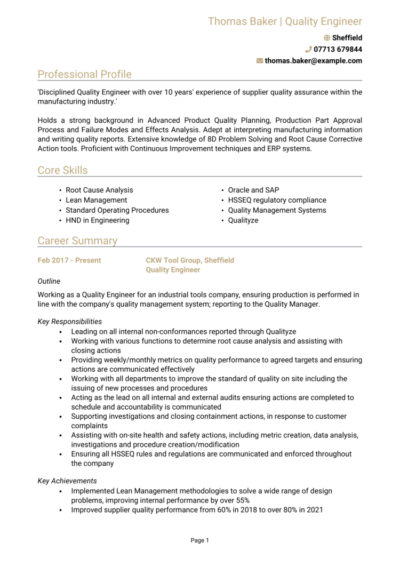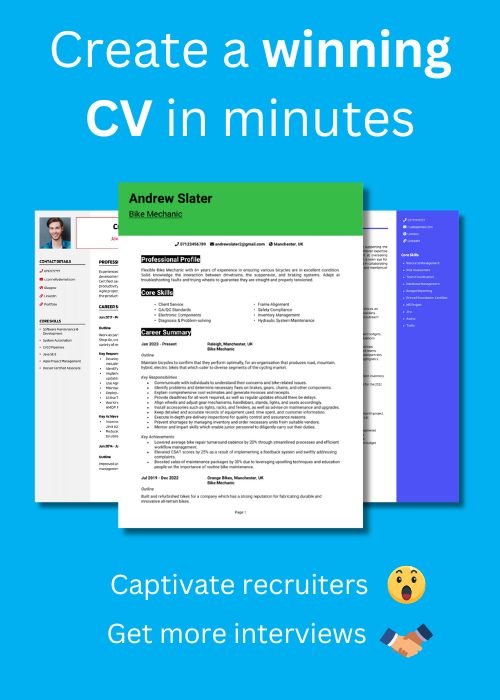Your spreadsheets are flawless, your root cause analysis is sharp – so why let a messy CV be your professional blind spot?
This guide and its Quality Engineer CV example will help you produce a polished CV that reflects your technical expertise, communicates your value clearly, and helps you pass the all-important recruiter test.
Quality Engineer CV
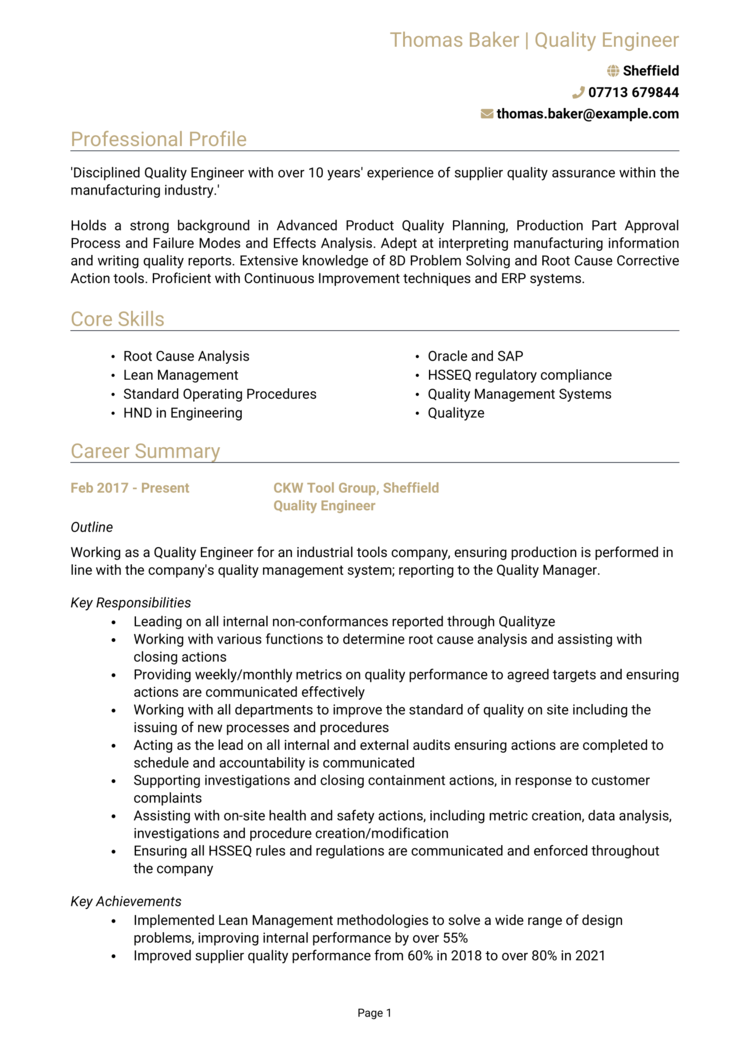
How to write your Quality Engineer CV
Discover how to craft a winning Quality Engineer CV that lands interviews with this simple step-by-step guide.
Quality control is all about accuracy and accountability – and the same should apply to your CV. Writing a CV needs to show that you’re not just ticking boxes – you’re driving real improvement.
This guide will take you step-by-step through how to produce and write a CV that highlights your top skills and the measurable results you’ve achieved.
The best way to structure and format your Quality Engineer CV
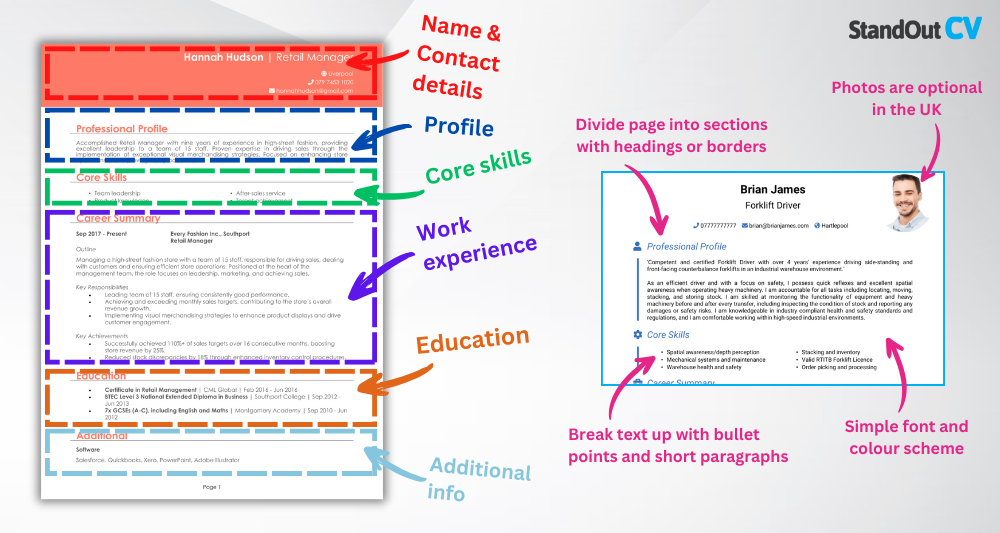
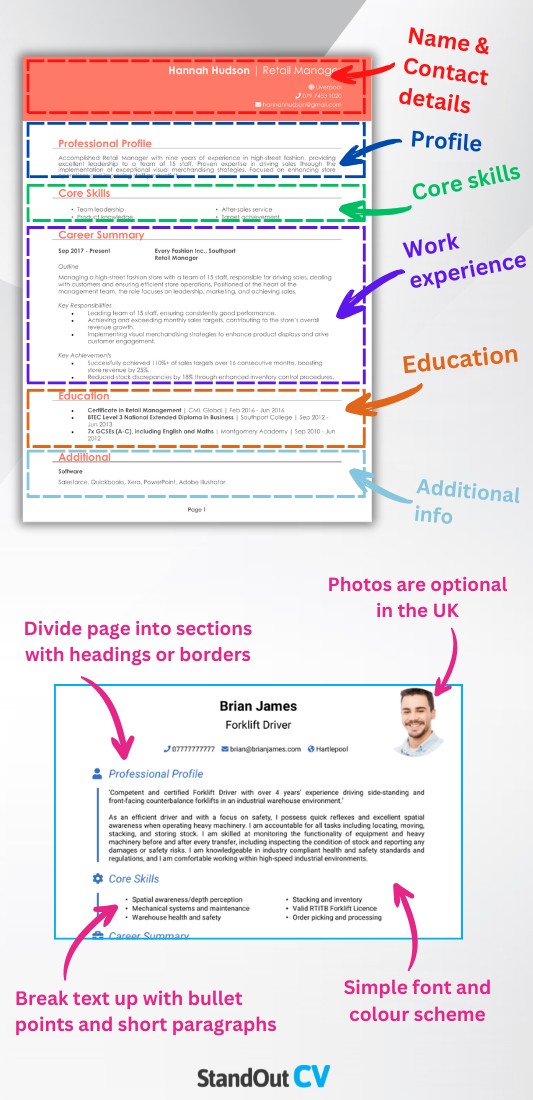
A quality engineer’s CV should reflect the same standards you’d expect from a process audit. You don’t want your key qualifications buried in clutter or your biggest achievements hiding in the margins. Think of your layout as a tool for presenting value, not just filling space.
Here’s the structure to follow:
- Name and contact details – Place your name and contact details prominently at the top of your CV for quick access. Adding a photo of yourself is up to you.
- Profile – Open with a compelling overview of your skills, experience, and career goals.
- Core skills – List your key abilities in this section, focusing on those that will be most relevant to the job.
- Work experience – Provide a detailed breakdown of your work history, starting with the most recent job first.
- Education – List your qualifications, including degrees and relevant certifications, in reverse chronological order.
- Additional info – Use this optional space for relevant hobbies or personal pursuits that enhance your application.
Spotting tiny mistakes is your thing – which means you already know the stakes of submitting a sloppy CV. To make a strong first impression, use bullet points to break up dense text and divide sections with clear, consistent headings. Choose a neat, readable font and maintain plenty of white space for easy scanning. Keep your CV to a maximum length of two pages and always put your most relevant experience and certifications at the top – because just like in a root cause analysis, order matters.
What is a Quality Engineer CV profile?


Your CV profile sits right at the top – it’s your first impression and acts as the quick validation that you know what you’re doing. This section needs to highlight your sector knowledge and the benefit you bring to an organisation’s processes and systems.
Briefly outline your experience and your track record: just enough information to convince recruiters you’ll continue doing what you do best at their firm.
Quality Engineer CV profile examples
Profile 1
Experienced Quality Engineer with over 14 years in the automotive manufacturing sector, supporting large-scale production lines and supplier quality management. Well-versed in ISO 9001 and IATF 16949 standards, carrying out audits, root cause analysis, and corrective action planning. Skilled in Six Sigma methodologies and the use of tools such as Minitab for statistical process control. Known for improving product reliability and ensuring compliance across high-volume operations.
Profile 2
Skilled Quality Engineer with seven years of experience in the aerospace industry, ensuring compliance with stringent safety and regulatory standards. Worked closely with design, testing, and production teams to resolve non-conformances and drive continuous improvement. Proficient in AS9100 quality systems, FMEA, and CAPA processes, with a strong ability to interpret complex technical drawings and specifications. Recognised for strengthening supplier quality frameworks across global supply chains.
Profile 3
Motivated Quality Engineer with three years of experience in a medical device manufacturing company, supporting new product introduction and post-market surveillance. Assisted in validation protocols, risk assessments, and quality reporting in line with ISO 13485 requirements. Comfortable using ERP and QMS software to track issues and monitor process performance. Demonstrated ability to collaborate with R&D teams and regulatory bodies to maintain high standards of product safety and quality.
Details to put in your Quality Engineer CV profile
Here’s what to put in your CV profile:
- Where you worked – Mention the types of environments you’ve worked in, such as regulated industries, high-volume manufacturing, or ISO-certified production facilities.
- Your top qualifications – Include formal qualifications or certifications that reinforce your credibility, such as Six Sigma training or ISO auditor certifications.
- Essential skills – Highlight core competencies that reflect your technical depth, such as process validation, internal auditing, documentation, or non-conformance management.
- Sectors or clients supported – Mention if you’ve worked in sectors like aerospace, automotive, pharma, or consumer goods – and what kind of teams or clients you supported.
- Value delivered – Make it clear how your work improved output quality, reduced errors, increased compliance, or contributed to operational excellence.
How to highlight your core skills


The core skills section of your CV is where you show that you’ve got the hands-on ability to back up your experience. Instead of vague buzzwords, this is where recruiters expect to see the kind of hard, technical competencies that match the job spec.
Avoid general traits like “attention to detail” – those are assumed. Instead, focus on CV skills that reflect your expertise in quality systems and regulatory standards. This section is especially easy to tailor for each role – just scan the job advert and reflect the key priorities it mentions.
Essential skills for a Quality Engineer CV
- Quality Control Inspection – Conducting inspections of materials, components, and finished products to ensure they meet specified standards.
- Root Cause Analysis and Problem Solving – Investigating defects or failures and implementing corrective and preventive actions.
- Statistical Process Control (SPC) – Monitoring and analysing production data to maintain consistent quality and detect variations.
- ISO and Regulatory Compliance – Ensuring processes align with quality standards such as ISO 9001 and industry-specific regulations.
- Process Auditing and Reporting – Performing internal and external audits to evaluate process effectiveness and identify areas for improvement.
- Supplier Quality Management – Assessing and managing supplier performance to ensure consistent quality of incoming materials.
- Continuous Improvement Initiatives – Leading Lean, Six Sigma, or Kaizen projects to enhance efficiency and reduce waste.
- Calibration and Equipment Validation – Verifying the accuracy of measuring instruments and ensuring equipment meets operational standards.
- Document Control and Quality Documentation – Maintaining detailed records of quality procedures, test results, and compliance reports.
- Cross-Functional Collaboration – Working closely with engineering, production, and procurement teams to resolve quality issues and drive improvements.
How to showcase your work experience in your CV


Your work experience section is where you prove that you don’t just understand quality – you’ve delivered it. Whether you’ve worked on supplier audits, defect investigations, or continuous improvement initiatives, this is your chance to show how your efforts led to measurable results.
Introduce each role with a short summary explaining your position and the type of company you worked for. Then use bullet points to highlight your main responsibilities and achievements, focusing on processes improved, systems implemented, or problems solved. List your roles in reverse order, starting with your most recent.
How to format previous jobs in your CV correctly

- Outline – Describe the company you worked for, the industry they operate in, and the overall purpose of your role within the quality function.
- Responsibilities – Use action words like “monitored” and “implemented.” For example: “monitored production processes to ensure ISO 9001 compliance” or “implemented a supplier audit schedule across three international sites.”
- Achievements – Demonstrate the impact you made – whether that’s reducing defect rates, improving audit scores, or speeding up product release timelines.
Example work history for Quality Engineers
Quality Engineer | Harrington Automotive Systems
Outline
Oversaw quality assurance for a tier-one automotive supplier producing braking systems for global car manufacturers. Ensured compliance with IATF 16949 requirements and worked closely with production teams to maintain defect-free output across high-volume assembly lines.
Responsibilities
- Conducted daily line audits and documented findings for corrective action
- Analysed statistical process control charts using Minitab to identify variations
- Led supplier quality reviews and evaluated incoming materials for compliance
- Collaborated with engineers to develop control plans and update PFMEAs
- Prepared customer-facing quality reports and responded to audit queries
Achievements
- Reduced customer complaints by 28% in one year by strengthening inspection processes
- Achieved zero major non-conformances in two consecutive IATF audits
- Introduced a supplier scorecard system that improved on-time delivery quality by 15%
Quality Engineer | Stratos Aerospace Components
Outline
Provided quality engineering support for a leading aerospace parts manufacturer, specialising in precision components for commercial aircraft. Ensured strict adherence to AS9100 standards and regulatory requirements while working across design, testing, and production teams.
Responsibilities
- Reviewed engineering drawings and created inspection plans for critical components
- Investigated non-conformances and implemented corrective and preventive actions
- Conducted first article inspections (FAI) in line with AS9102 requirements
- Liaised with suppliers to resolve quality issues and verify material certifications
- Prepared quality documentation for internal and external audits
Achievements
- Reduced non-conformance reports by 35% over 12 months through process improvements
- Supported a successful NADCAP accreditation audit with zero findings
- Implemented a new FAI process that cut approval time by 25%
Quality Engineer | Meditech Devices Ltd
Outline
Worked for a fast-growing medical device manufacturer, supporting quality systems and regulatory compliance across multiple product lines. Contributed to both new product development and ongoing production, ensuring adherence to ISO 13485 standards and MHRA requirements.
Responsibilities
- Assisted in validation protocols for new product introduction projects
- Conducted risk assessments and updated design history files
- Performed internal audits to monitor compliance with quality management systems
- Monitored complaints data and supported post-market surveillance activities
- Maintained QMS records in ERP systems, ensuring accuracy and traceability
Achievements
- Helped reduce CAPA closure times by 40% through better tracking and escalation
- Contributed to the successful CE marking of three new product launches
- Improved audit readiness by developing new checklists and training materials
Structuring your education section


In quality engineering, education supports your credibility – especially when combined with industry-specific certifications. Use this section to outline your academic foundation and any additional training that enhances your professional profile.
Start with your most recent or relevant qualification. This might include a degree in engineering, manufacturing, or materials science, as well as any supplementary certifications related to quality management, regulatory standards, or process improvement. You don’t need to list every course – just the ones that reinforce your technical value.
Top qualifications to showcase on a Quality Engineer CV
- BEng or BSc in Mechanical Engineering, Manufacturing Engineering, or similar – A strong academic base in technical and production principles
- Six Sigma Green Belt or Black Belt Certification – Widely respected for process improvement and defect reduction
- ISO 9001:2015 Lead Auditor Certification – Essential for roles involving compliance and audits
- Level 4 Certificate in Quality Management Systems – Offers recognised training for senior QA roles
- NEBOSH Certificate (if applicable) – Useful if your quality role crosses over with health and safety responsibility


